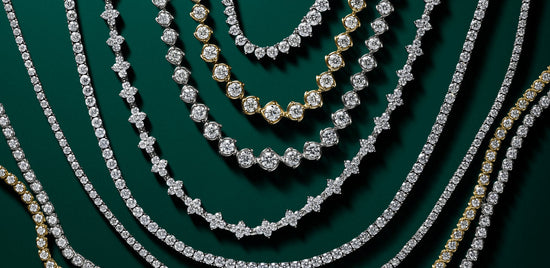What is a Pink Sapphire?
Sapphires occur naturally in various colors, such as blue, yellow, green, white, and, you guessed it, PINK! Pink sapphires can range in color from pale pink to deep magenta and can have purplish pink or orangey hues, like the rare Padparadscha stone. Pink sapphires are often used in jewelry as an alternative to diamonds or to add a whimsical and feminine touch to gorgeous diamond jewelry.
As a member of the corundum family, the pink sapphire is colored by trace amounts of elements such as titanium, iron, magnesium, copper, and chromium. Deep pink sapphires have higher amounts of chromium than light pink sapphires, and in some cases, it can be difficult for non-experts to determine the difference between a pink sapphire and a ruby. In fact, different regions use different criteria to determine the threshold for when a sapphire can be labeled a ruby.
Regardless of how similar in color a pink sapphire may be to a ruby, rubies are more esteemed and more expensive than pink sapphires. The one exception is the rare and valuable orange-pink Padparadscha stone from Sri Lanka, whose name comes from the ancient Sanskrit word used to describe the color of a tropical lotus flower.
Despite the range of colors and price tags associated with pink sapphires, experts suggest buying based on your own preference and whichever variation of pink sapphire speaks to you. Whether you opt for a deep purple-pink stone or the illusive Padparadscha, pink sapphires represent loyalty, faithfulness, honesty, peace, and balance. No wonder the pink sapphire continues to rise in popularity for engagement rings and meaningful gifts!
How are Pink Sapphires Graded?
Although color is the most critical factor for grading a pink sapphire gemstone, gemologists also consider the cut, clarity, and carat of the stone, which determine the stone's rarity and price.
Color: Pink sapphire’s color is graded on three factors: hue, tone, and saturation. The more intense and deep the color, the more valuable the stone. Although, rare colored pink sapphires, like Padparadschas, can be quite expensive due to their scarcity. A sapphire’s color is graded with a system that categorizes gemstones—AAA (Heirloom), AA (Best), A (Better) to B (Good). Only 1% of natural gemstones are grade AAA. 10% of gemstones are grade AA, and 20% are grade A. AA and A graded gemstones are most commonly used in fine jewelry.
Cut: Gemstone cutters aim to minimize the visible inclusions within a pink sapphire while maximizing the beauty and color of the stone. The right cut can enhance the gemstone’s vibrant color, and a poorly cut pink sapphire may appear dull or lifeless. Pink sapphires should be cut in a complementary shape with symmetrical facets to return the greatest amount of light.
Clarity: While inclusions are a sign of a natural gemstone, they can be distracting and even obscure the natural beauty of the stone. Sapphire gemstones are put into one of three categories for grading clarity: Type 1, Type 2, and Type 3. Type 1 pink sapphires are the most valuable and appear “eye clean,” with no visible inclusions to the naked eye. Type 2 pink sapphires have minimal visible inclusions that do not detract from the beauty of the sone. Type 3 pink sapphires have many visible inclusions visible to the naked eye. Overall, a pink sapphire without visible inclusions (Type 1) is rare and thus will be priced higher than a stone with many visible inclusions (Type 3).
Carat Weight: Generally, the greater the carat weight, the higher the price. The same is true for pink sapphires. Sapphires are heavier than diamonds, so a 1-carat pink sapphire will appear smaller than a 1-carat diamond.
Where do Pink Sapphires Come From?
While Madagascar, which started mining pink sapphires in the late 1990’s, produces most of the pink sapphires, Sri Lanka and Myanmar have been producing stunning pink sapphires for centuries.
In fact, the gems gifted to the Queen of Sheba by King Solomon in the Old Testament originated on the island of Ceylon, now known as Sri Lanka. Although the same cannot be said about rubies, a pink sapphire’s origin does not greatly impact its price and value.
How are Pink Sapphires Treated?
The most common and widely accepted treatment for sapphires is heat. Heat can permanently improve color and clarity to enhance the color’s intensity and lower the visibility of inclusions.
Heat treatments diminish the purple hues often present in pink sapphires. Although an untreated pink sapphire without purple hues will be more rare and expensive than a heat-treated pink sapphire also without any purple hues, heat treatment does not significantly alter the value of the stone.
There are treatments other than heat for pink sapphires that are less permanent but affect the value of the stone. Some treatments include filling fractures and inclusions with molten lead, and diffusion treatment, where a thin layer of color is applied to the stone’s surface. These types of treatments are mostly applied to lower-quality stones and are for cosmetic and durability purposes.
How to Care for Pink Sapphire Gemstone Jewelry?
Pink sapphires are graded on the Mohs hardness scale, which grades based on how easily one mineral can be scratched by another. While the scale grades from 1 to 10, the steps aren’t evenly dispersed. For example, while sapphires are a 9 on the scale and diamonds are a 10 on the scale, diamonds are many times harder than sapphires. Regardless, the sapphire has excellent toughness and is not easily broken when struck, so it is a great choice for everyday wear.
Pink sapphires are considered “stable,” which means they are unaffected by heat, light, and common chemicals. However, boric acid powder can scratch the surface of an untreated sapphire gemstone. Lemon juice and other mild acids can damage fracture-filled and dyed sapphire gemstones.
While fracture-filled and dyed stones should only be cleaned with a damp cloth, untreated, heat-treated, and diffusion-treated sapphires can be cleansed with warm, soapy water, ultrasonic cleaners, and steam cleaners.
Before cleaning your pink sapphire gemstone jewelry, ensure that the metal used to set the stone will not be damaged. Use caution when wearing or cleaning color-treated or fracture-treated stones since they can be damaged by various chemicals and require a higher degree of care.
Conclusion
There’s a reason the stunning pink sapphire gemstone has garnered so much attention in the past few years. Pink sapphires are feminine, elegant, durable, and, above all, sparkly!
Both real and fictional brides, including Elle Woods in Legally Blonde 2 (2003), are opting for a blush pink or magenta engagement ring moment over a traditional white diamond ring for added vivacity. Fun, bold, energizing, and confident perfectly describe the pink sapphire gemstone.

Visit us at Brandon Boswell Diamonds, the premiere destination for luxury jewelry in Palm Desert, for a a one of a kind shopping experience.












